Guest Post by Adrienne Ruork
Whoever decided that doves were an emblem of peace and love was the biggest con artist of all time. Unless doves have since evolved with humanity’s embrace of satirical humor, we’ve been victims of this fallacy our whole entire lives. From Sunday bible teachings, to Greek mythology taught in high school, to cartoons and other media depicting doves as heralding peace—it’s been ingrained in our brains that doves are peaceful, gentle birds.
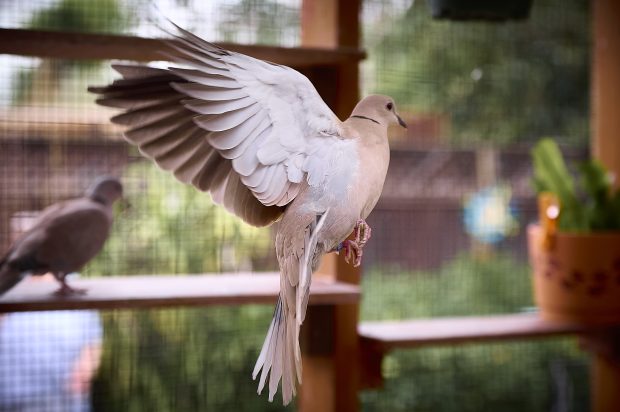
Plover, a rescued Eurasian-Collared Dove, enjoying flying about in a predator and rodent-proof aviary. Photo by me.
Lies. It’s such flippant deceitfulness that I dare say it’s on par with the big ones like Santa Claus, Milli Vanilli singing their own songs; and pigeons being disease-riddled, stupid birds. Anyone who has spent any amount of time with a dove knows they are pixies in disguise. They prey upon and weaponize our naivete all with a blink of those sweet, beady eyes and an adorable beak smack or two. Isn’t it just the cutest thing when they puff up and start smacking their beak with contentment? And when they nuzzle their own face down into their feathery bosom, it makes me wanna—hey wait a minute! See? I’m falling for their trickery right now!
While pigeons are Lords of the Leisure Arts, doves must be the Chancellors of Chaos—and this is coming from someone who has rehabbed raccoons and crows, two of the most notoriously devious wildlife here in California. Ringneck doves, for example, are often nicknamed laughing doves for a reason— because they cackle like little flying maniacs who laugh at the mischief they wrought upon their caretakers. Eurasian-Collared doves do nothing but scream; I would know, I have two. They’re so unhinged they feel the need to scream when landing upon your head as if to remind you of their unpredictability. What better way to assert dominance than to scream at everyone around you? I mean, it works for toddlers, and those are some of the most capricious beings on this planet.
Doves are constantly on the prowl for something to do. They’re busybodies, unlike their pigeon counterparts who love to loaf it up in the sun. Even when doves are perched, they’re still doing something, whether it be preening or plotting world domination. Those pebbly eyes are like spy cameras scanning their territory for potential threats. Threats, of course, being other doves encroaching on their favorite spot, or even their favorite human slave. If you’re lucky enough to be deemed worthy, a dove will consider you their property and defend you against anything that comes near. If a dove were a color, they’d be green because of how jealous they can become. That’s not to say they can’t coexist with other doves. Quite the contrary.
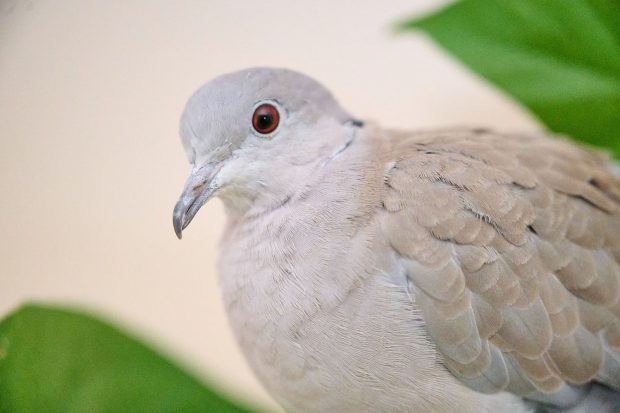
Eurasian-Collared Dove, Maple, staring into my soul with the intent of who-knows-what. Photo by me
At their core, doves are flock animals. They seek accomplices their own kind for dominance protection against predators and competition. The more the better in the wild, but in captivity they do best in a flock of at least four. It’s possible to have one to two doves in an indoor setting, but only when the humans become their flock. They can easily thrive with humans who are homebodies and can spend a lot of time worshiping the very perch they stand on. If you work out-of-home, or spend a lot of time elsewhere, a single dove would not bode well; they can easily become depressed, stressed, and insecure all alone.
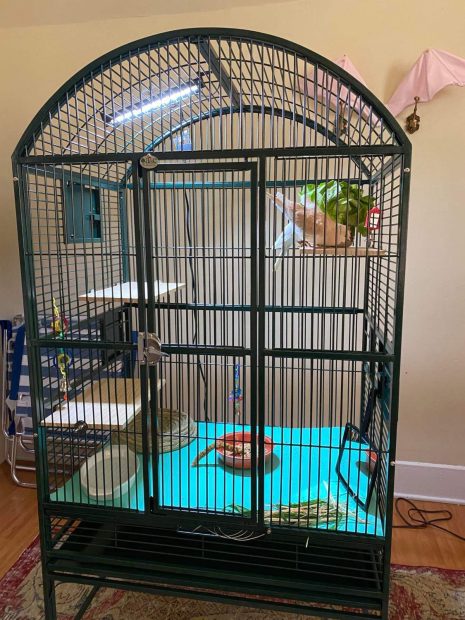
For indoor doves, Palomacy recommends a cage with a minimum dimension of 32”Wx32”Hx21”D. This is suitable for one to two doves. However, as with all animals in captivity—the bigger the better. For specific information on cages, check out our article on proper cages and housing here. Photo by Elizabeth Y.
The two most common species of dove that Palomacy gets through its doors is the domestic ringneck dove; and the non-native, technically invasive Eurasian-Collared Dove (EUCD). They are very similar in size, but ringnecks have a wider variety of color than their EUCD counterparts. They can come in many colors such as white, peach, fawn, cream, and even pied.
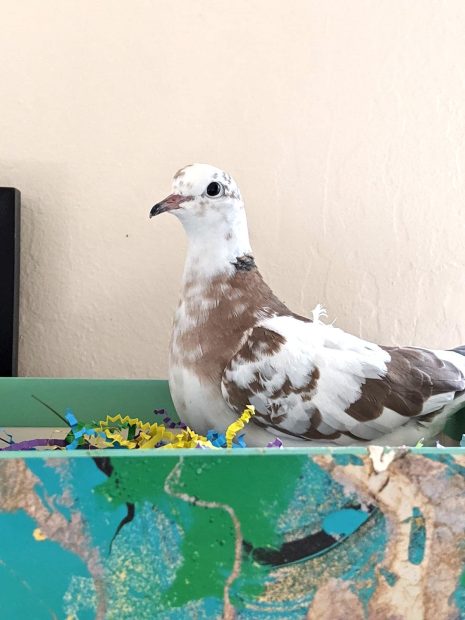
Lindy, a pied dove, showcasing the beautiful patterns some doves can have. Photo by Liese H.
EUCDs on the other hand are a more modest tan or gray with a gorgeous hint of lavender winking through in some light. Rarely, a EUCD can be more on the creamy fawn side, completely throwing off even the keenest of experts into thinking it’s a domestic ringneck at first glance. What better way to overthrow society by blending in with the crowd?
The majority of both species wear the trademark “ring” on the nape of their neck. It’s a crescent moon-shaped band of usually black feathers, but in some colorations, it can be a lighter ring of brown or even peach.
White ringneck doves, again probably just to screw with us, have a white ring.
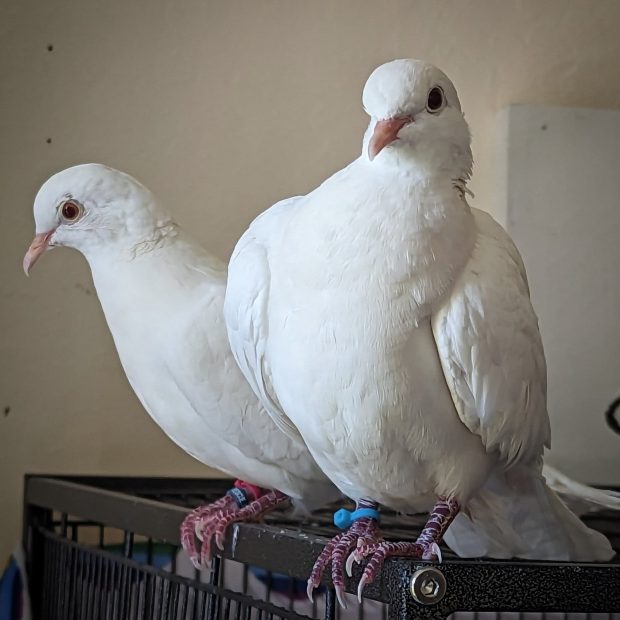
Idyll (left) and Garfie (right) with their nearly invisible white on white rings . Photo by Liese H.
Despite being two different species of dove, they can co-exist in a mixed flock since they are both of similar size and temperament. As for what kind of temperament each has, well, truthfully that’s as unique as our own fingerprints. Eurasian-Collared Doves are known to be territorial and rowdy, but they can also be loving and cuddly towards their mate or their chosen human(s). Despite being a domestic species, not all ringnecks necessarily want to be handled and would much prefer to be admired with the eyes. Each will have their own likes and dislikes, their own level of tolerance of proximity to one another, their own picky preference for a place to perch. Some are shrewd, some are demure, some will be shy one minute and then bold the next. And then there’s some who will be so clingy they become akin to a fashion accessory.
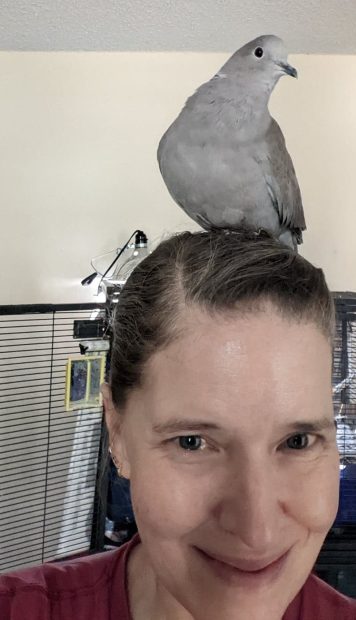
JillBonnet was named after the fact that she loves to sit atop heads like a fancy little bonnet. Picture by Liese H.
There is truly no disadvantage to any dove, regardless of their personality. Ignoring the fact that I began this article claiming that doves are the Chancellors of Chaos, it’s said with the utmost love and adoration. Indoor doves, when given the opportunity to free fly throughout the house, will surely find a spot to coo for you for hours. They’ll perch on top of the refrigerator to watch as you make your morning coffee, they’ll join you on the back of the couch as you catch up on your favorite show. And in their predictably unpredictableness, they’ll land on your head during the most important zoom call of your life and laugh or scream their lungs out.
In a flock dynamic, doves can really begin to shine with their dispositions and idiosyncrasies. Unlike pigeons, who are relatively monogamous, doves are known to be quite the little swingers. They’re a little less concerned with conventional (and human) definitions of relationships, and spend a lot of their time being busybodies with, well, anybody. While it probably doesn’t hold a candle to college kids during spring break, doves tend to jump around with whom they can by day and retire to their nest with their main mate at night.
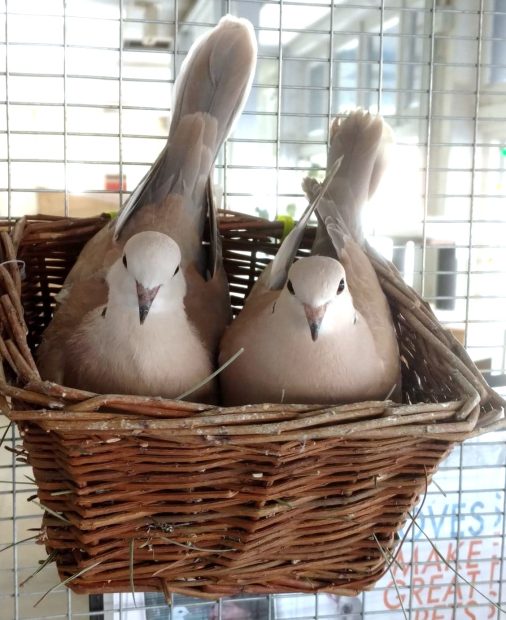
Snuggly mates Eggbert and Avery in their nest. Photo by Liese H.
There are squabbles over seed, battles for the best sunbeams, dive bombing each other for hogging a good preening spot. There’s always a cacophony of hysterical laughing from the ringnecks and maniacal screaming from the EUCDs. Needless to say, doves are pure entertainment. There’s never a dull moment with a dove, whether you have one or an entire flock of them.
Sometimes there isn’t a clean moment either. If you’re lucky enough to befriend a dove, you’ll soon learn they have an uncanny similarity to a dog in that they’ll not only beg for food, but they’ll take matters into their own beak to taste whatever it is you’re eating. Plover, my EUCD, somehow beguiled me into giving her a tiny taste of Pringles. Since that fateful day, I can no longer buy Pringles lest she land upon my hand as soon as it dives in to grab a chip. Once that chip emerges from the depths of that iconic cardboard tube, she crunches down before I can even begin to raise it to my own lips. The delicate treat then crumbles through my very fingertips, landing upon my lap (and the floor) like shattered dreams. Needless to say, it’s good motivation to no longer buy junk food.
Dinner time has been messy chaos. On one particular occasion, my mom and I had just sat down to a simple dinner of spaghetti. With a lot of sauce. The red kind. The kind that stains. For reasons only known to the twisted depths of Plover’s mind, she decided to divebomb and crash land in my mom’s spaghetti. She stomped around on the plate with pride, mashing the pasta between her toes as though grape-stomping an artisanal wine to go with our meal. Her breast and legs were tainted red much like my fingers after eating an entire bag of Flaming Hot Cheetos. Dinner was certainly ruined, but the memory of this silly little dove making spaghetti wine was entirely worth the struggle of bathing her afterwards.
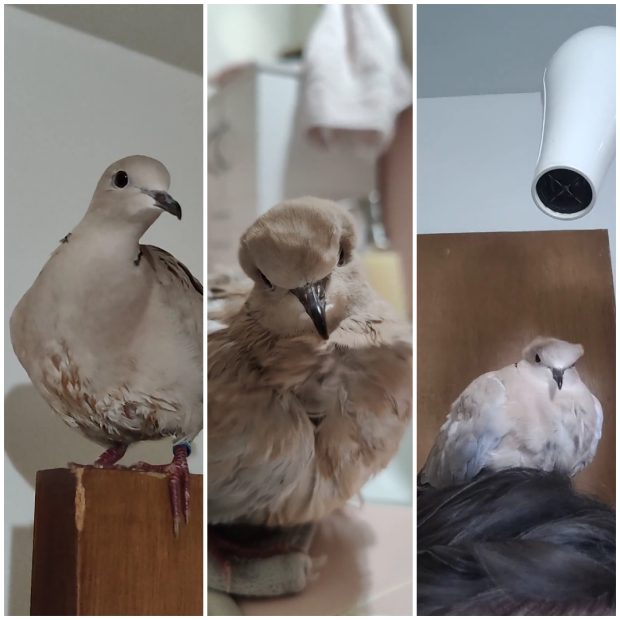
Left: Plover post-spagetti winemaking. Middle: Plover post bath. Right: Plover getting a blow dry atop my head, possibly (?) regretting her life choices.
Despite the ruckus these birds may kick up on a daily basis, doves have an undeniable charm. There’s the draw of innocence from their vibrant eyes. The way they tilt their head to view their world is the very essence of pure curiosity (something, as humans, we lose as we age). This is why I liken them to pixies—they’re blithe and spirited creatures of whimsy and mischief. There’s comfort in their presence, even if they’re on the other side of the room merely observing you as you go about your day, or you’re watching your flock simply exist in the moment. They’re very much soothing to the soul to have as companions in any capacity. Through spending time with my doves, and through my time volunteering with Palomaccy, I’ve come to an epiphany that the peace doves are known to represent is more of an inner peace they bring to the lives of their caretakers. And to me, that is a peace that is far worth the occasional chaos.
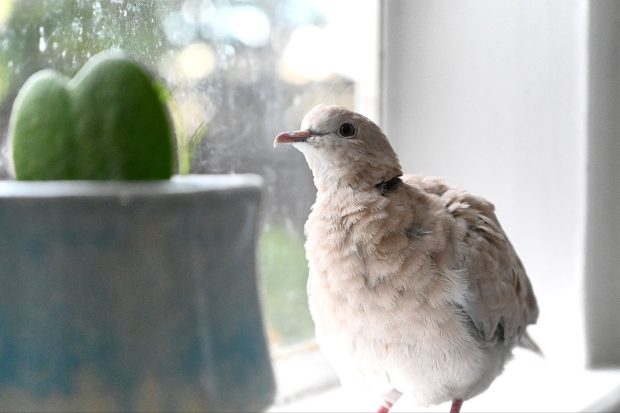
Plover inspecting a plant. Doves absolutely love to root through plants and munch on their leaves. Protect your dove by choosing non-toxic, bird safe plants. Protecting your plant from the dove is another story. Photo by me.
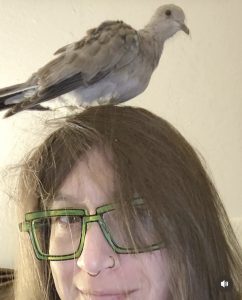
Adrienne has been a volunteer with Palomacy for only a short while, but she hit the ground running. Aside from caring for twenty-two rescue pigeons and two rescue doves, she is also the Bird Database Coordinator for Palomacy, as well as a member of the Phone and Social Media teams. Her hobbies include snuggling pigeons, cleaning pigeon poop, taking pictures of pigeons, thinking about pigeons, huffing pigeons, getting wing-slapped by pigeons, and basically forfeiting any and all free will to her pigeon and dove overlords.

